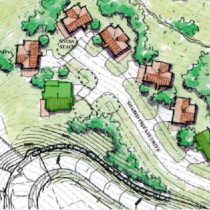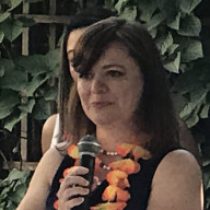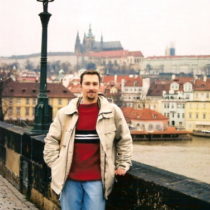Landscape Architecture for Landscape Architects › Forums › GENERAL DISCUSSION › To Trace or Ray Trace-Are we helped or handcuffed by technology?
- This topic has 1 reply, 20 voices, and was last updated 13 years, 7 months ago by
 Trace One.
Trace One.
-
AuthorPosts
-
November 30, 2010 at 7:44 am #166671
 earthworkerParticipant
earthworkerParticipantThe recent technology discussions have me wondering if our latest rendering and visualization programs are progressing the industry or limiting our creativity and good design sense? Are the countless hours perfecting a 3d tree worthwhile when in that same time we could create two hand-drawn perspectives, a section/elevation and sample plant palette for client review?
It seems that our profession, more so than even architects and engineers, is about craft and organic insight. We seem to be losing these assets starting at the academic level and it is creeping into professional offices (at least those still in business). I wonder: Does anyone even draw anymore? Is it even necessary? And why do I even care about drawing when there are no jobs to be had anyway?Yours Truly,
A landscape architect in crisisNovember 30, 2010 at 11:42 am #166717 Trace OneParticipant
Trace OneParticipantYou have to draw to think..Even with the prevalence of computers, reallly for everything,( one still uses sketching, drawing, plan and section, to think..IMHO..
November 30, 2010 at 12:50 pm #166716 Andrew Garulay, RLAParticipant
Andrew Garulay, RLAParticipantIt depends what you are working on and it also depends on your own physical abilities to draw as well. The result that we are actually after is what is built on the ground. How we get there does not matter outside of communicating those ideas prior to the fact, marketing, and being competitive with others.
Do you truly need to draw well to be a landscape architect or to think? I sure hope not because I don’t have gifted hands. I dropped out in ’83 because at the time drawing was everything. I went back and cruised to a degree while working almost full time when CAD made that a non-issue.
There are many ways to skin a cat. The more tools you have the more options you have in how you communicate. Communication can be done in many ways.
I do think it is always a risk when educators time is spent on things other than building knowledge within their students. Knowledge is necessary in order to effectively design nice built work on the ground. You have to know what you want to communicate or it is not worth much no matter what media you communicate with.
November 30, 2010 at 1:07 pm #166715 Trace OneParticipant
Trace OneParticipantyeah – Andrew, you have a point… I work with other guys now who are thrilled by the computers ability to get around their lack of drawing ability..
but how do you work out your plans? Do you sketch in the computer?
November 30, 2010 at 2:40 pm #166714 Frank VarroParticipant
Frank VarroParticipantOne of the advantages of technology is that it is infinitely repeatable. So yes, right now I could draw a few hand perspectives of the work that, as you put it, doesn’t exist for me right now, or I can perfect a model of a 3D tree. then, when it comes time to make a model for a paying client, I am able to give them a 3D universe that they can not only get unlimited still images from, but animations as well, and they look all the better because of the work I’m doing now to perfect my model components.
Computer viz is just a new form of rendering, and one that suffers from different difficulties from hand drawing. Its less reliant on physical skill, but more reliant on software knowledge. It is repeatable, but takes more time on the front end. It is more realistic, but, unless done well, less emotional.
I can draw, and I draw when I’m designing. But I know my skill set enough to know that I can get better results with a 3Dmodel than with a hand perspective.
November 30, 2010 at 3:03 pm #166713 Amy VerelParticipant
Amy VerelParticipantLooking at all of the recent discussions, technology is well represented but not overwhelming other topics. Obviously it plays an extremely important role in our profession, particularly to young professionals on the job market, but I don’t agree that it’s dominating us or that we’re losing what’s important. We’re simply acclimating to the cultural shift of integrating technology into the design and production processes, a challenging and rewarding task that is constantly evolving.
Among the many complex things that are important in that respect, one of them is the fact that it draws such a wide diversity of professional backgrounds, personalities and interests. This may lead to a little more friction but it’s a good friction and it’s good for the design process and the profession as a whole. “Hours spent perfecting a 3d tree” may seem like a waste of time to you because of your background and interests, and there’s nothing wrong with that; do what you enjoy and find the most rewarding/productive/challenging about the design process and you, and we as a profession, will all be well.
Understand though that someone else with different talents, interests and perspective on the profession may find those same hours spent on perfecting that 3d rending to be precisely the thing that works for them, and that their differing approach does not necessarily communicate a lose of “craft and organic insight.” It also evinces no indication that they don’t draw, so that is an unfair assumption. There are indeed many ways to skin a cat, just as there are too few hours in the day to worry too much about other people’s skinning techniques.
November 30, 2010 at 3:07 pm #166712 Trace OneParticipant
Trace OneParticipantYou sound very organized, Henry! But I agree – the ‘ show me’ problem – also exists when out walking around talking to clients – if you can sketch up an idea right there, they like it..sometimes..
I like this New Yorker thing – every week the guy draws some kind of painting, using his finger, on his iphone..Perhaps the computer oriented could use this for on-the-spot thinking..although I geuss you still have to be able to draw.. oh well..I just like this link..
http://www.newyorker.com/online/blogs/fingerpaintingNovember 30, 2010 at 6:03 pm #166711 Andrew Garulay, RLAParticipant
Andrew Garulay, RLAParticipantI do draw to work things out for myself, but it is not as constant as it is with many other LAs or as much as I was told was absolutely necessary while going through school. It is like a Smart Phone, if you have a good one you use it all of the time, but if you don’t, you find a way to stay productive. …. but you still need a phone!
November 30, 2010 at 6:32 pm #166710Tanya Olson
ParticipantFor smaller projects (residential) I hand-draw – its fast and the clients think its magic.
For larger projects, particularly with lots of trees or complicated landscapes that would not be represented accurately by hand, I use photoshop with effects. Its fast and the clients think its magic!In hand drawing I often go back and forth with acad plans to see if my ideas will actually fit (perspectives can be deceptive). I draw and compute with just a turn of my chair. Personally, I started with drawing then tucked computer technology in the same right side of my brain….for me they are different tools used in the same way.
I agree with Andrew that the result we are after is what gets built, but an accurate and artful rendering of what will be built can excite a client in a way that a plan by itself never will AND they know what to expect from the project. Accurate renderings = fewer surprises = happy client. Also – the better my renderings, the better my ideas were received in the office…I’d say its worth it to keep up your chops, whatever your chops may be- hand or computer….
November 30, 2010 at 8:01 pm #166709 Thomas J. JohnsonParticipant
Thomas J. JohnsonParticipantHand drawing is irreplaceable. You cannot think or design as quickly on a computer because it is too rigid. With a computer, you have to think, “how can I get the computer to perform this function in order to illustrate this idea?” With hand rendering, there is an immediate connection. If you can see it in your minds eye, you can draw it on paper. The thought process is different. You are thinking about the design, not how to get a computer to illustrate the design for you. The advantage is that you can quickly work through design iterations on your own or in a collaborative fashion. Try sitting down with 3 people and designing on a computer… you end up with a bunch of fingers pointing at the screen. “no, there, over a bit, down some, move it here…” Sit down with paper and pen and people can communicate and get DESIGN done.
With 3d modeling especially, everything is related. If you change your design, it creates a chain of events that require you to modify other 3d elements and it can become a very time consuming endeavor.
As Amy said, a lot of it comes down to your passion. Some people really enjoy making the perfect 3d tree. I might argue that those people are probably not landscape architects, that they are probably digital illustrators. If you want to spend days making a tree that’s fine. You should work for Pixar or some other digital imagery studio but I don’t know of any LA firms that are willing to pay people to do that kind of work. It’s not cost effective unless you are creating a digital entourage library to sell or use in movie production.
In this highly competitive market, speed is the name of the game. Profit comes from being able to go from concept to construction documents as fast as possible without compromising good design or quality. Hand drawing should always be the first step in the process. That makes you the designer. Get it close by hand, then dial it in with CAD.
As far as digital drawing being useful in client meetings, I don’t think we’re there yet. Those iphone drawings were impressive but you couldn’t do that with a client. With a client, you probably have 2 minutes, tops, to draw. It’s about quick sketches, showing the concept / intent. Pen and paper work best for that.
The one area where I see advantages in digital is with an existing picture of the site (perspective). With Photoshop, I can quickly drag in “entourage” (if there is a good library) and create a pretty accurate before / after image of the site. With good, pre-cutout entourage, you can create a nice digital composition in 20-30 minutes which might be faster than hand rendering. The results are also pretty photorealistic, which clients tend to like.
I guess it’s all about the right tool for the job… knowing when to use what.
November 30, 2010 at 10:26 pm #166708 Andrew Garulay, RLAParticipant
Andrew Garulay, RLAParticipantIf you draw using CAD forty hours a week for years, it becomes very second nature and not at all awkward. A pencil is more awkward to me now.
I remember when I first started doing plans in CAD. It made me crazy (yes, that is what did it) because I had no “feeling” of scale. I could not tell if I was looking at two inches or two hundred feet. But I have not had that problem in years. I think it is mostly due to being familiar with certain things in a drawing (or putting familiar things in drawings) . If you don’t get past that point, CAD will always feel awkward.
You just don’t have a CAD program and monitor in your back pocket everywhere you go.November 30, 2010 at 11:22 pm #166707 Thomas J. JohnsonParticipant
Thomas J. JohnsonParticipantDon’t get me wrong, I love CAD. It’s an essential tool. I love it’s precision and the ability to easily update drawings and exchange information with other people. Nothing beats it for production. But it’s not where I like to start.
If I’m going to design anything, whether it be a park or a bench, I start with pencil and paper. How can you take a base map of a site and start designing a park in CAD? I’d rather do 5 quick sketches to establish the form, the layout, the big idea and then bring it into cad. Then I might establish main axes, roads, walls, etc in CAD to make sure it all fits. Then draw over that for grading and planting. Bring it back into CAD to Dial it in.
I’ve never had the problem of losing a sense of scale in CAD. The thing that drives me crazy about it, is zooming in and out, the harsh colors, managing line weights and layers. It’s not easy on the eyes or the mind. I have no problem doing those things, in fact I take pride in having clean, well managed CAD files but it’s not what I prefer to think about. I have none of those concerns with a pen in hand…
December 1, 2010 at 12:03 am #166706 Thomas J. JohnsonParticipant
Thomas J. JohnsonParticipantNeed a new Junior Designer…? 🙂 I can be there by Monday
December 1, 2010 at 12:44 am #166705 BoilerplaterParticipant
BoilerplaterParticipantEven Luxembourg is doing better than the US?!
December 1, 2010 at 12:55 am #166704 Jennifer de GraafParticipant
Jennifer de GraafParticipantAGREED! 1 million %
-
AuthorPosts
- You must be logged in to reply to this topic.

